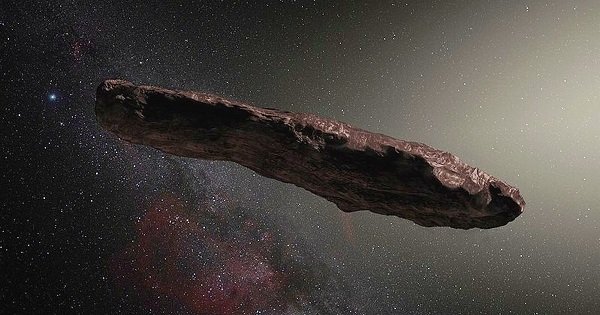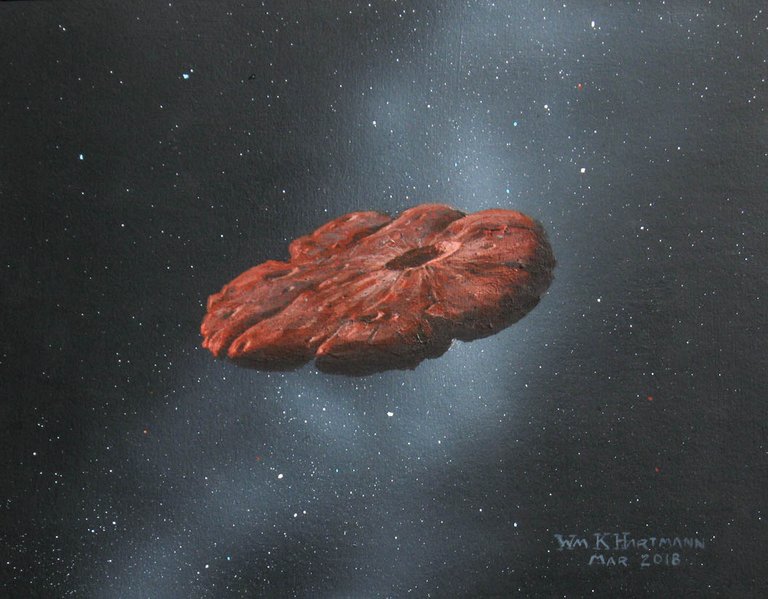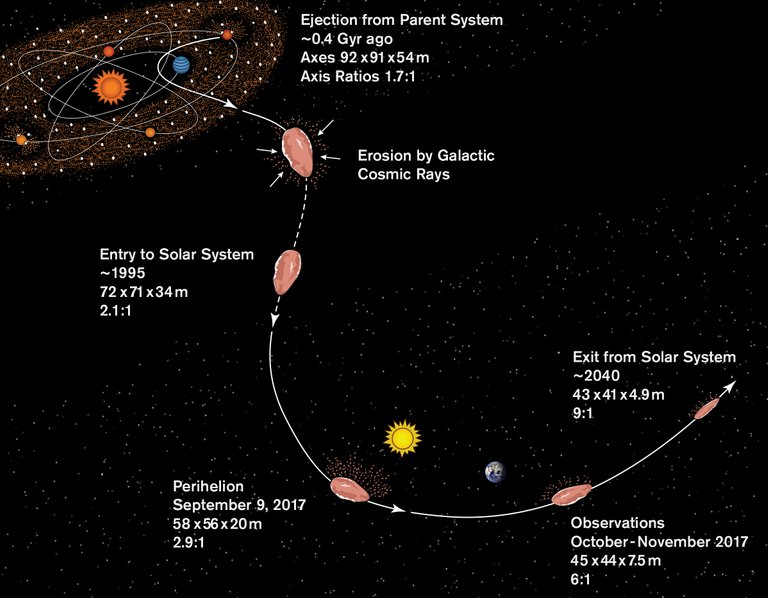New studies on the first Interstellar object detected. (EN - CAST) Nuevos estudios sobre el primer objeto Interestelar detectado.
Oumuamua

Souce
Oumuamua is the first interstellar object detected that is well known, but what exactly is it, initially it was thought that it was a comet after an asteroid was later seen to behave a bit strangely, there is even an astronomer who says it is the rest of an alien spacecraft, now four researchers from Arizona State University claim that it is the rest of a dwarf planet, similar to Pluto.
Oumuamua es el primer objeto interestelar detectado eso se sabe bien, pero que es exactamente, inicialmente se pensó que era un cometa después que un asteroide posteriormente se vio que se comportaba de forma un poco extraña, incluso hay un astrónomo que dice que es el resto de una nave extraterrestre, ahora cuatro investigadores de la universidad estatal de Arizona afirman que se trata del resto de un planeta enano, similar a Plutón.

Souce
The research is the product of scientists a la Jackson and Steven des presented their results on March 17, during the 52nd planetary and lunar science conference, scientists believe that Oumuamua is made of solid nitrogen or frozen nitrogen, similar to what we would find on the surface of Pluto, this would explain the acceleration detected when Oumuamua moved away from the sun, since the solar heat would thaw the nitrogen and when it was expelled it would have a slight rocket effect, this explanation would also give an answer to the strange flat shape of Oumuamua since the wear due to the loss of ice would be similar to what happens to a bar of soap that becomes flattened with use, in fact the researchers believe that Oumuamua has suffered a lot due to its passage near the sun since They have calculated that before entering the solar system this object was not flat. But the sun's heat has melted it down to 95 percent of its initial mass, what remains of Oumuamua is only a small remnant of what it was before entering our planetary system.
La investigación es producto de los científicos a la Jackson y Steven des presentaron sus resultados el pasado 17 de marzo, durante la 52 conferencia de ciencias planetarias y lunares, los científicos creen que Oumuamua está hecho de nitrógeno sólido o nitrógeno congelado, similar a lo que encontraríamos en la superficie de Plutón, esto explicaría la aceleración detectada cuando Oumuamua se alejaba del sol, ya que el calor solar descongelaría al nitrógeno y éste al salir expulsado haría un ligero efecto de cohete, esta explicación también daría respuesta a la extraña forma plana de Oumuamua ya que el desgaste por la pérdida de hielo sería similar a lo que le pasa a una pastilla de jabón que con el uso se va quedando aplanada, de hecho los investigadores creen que Oumuamua ha sufrido mucho muchísimo por su paso cerca del sol ya que han calculado que antes de entrar en el sistema solar este objeto no era plano. pero el calor del sol lo ha derretido hasta el 95 por ciento de su masa inicial, lo que queda de Oumuamua es solamente un pequeño resto de lo que era antes de entrar en nuestro sistema planetario.

Souce
To reach this conclusion, the researchers hypothesized that the object was made of different ice and calculated the speed with which each of the different ice would sublimate, that is, it would go from solid to gas due to the heat from there They made the calculations of the rocket effect, the mass, the shape of the object and the reflectivity of the ice, they were discarding various materials that did not fit in the observed data, until they found a type of frozen material in particular, solid nitrogen or frozen nitrogen that provided an exact match with all the features that had been seen from Oumuamua and since solid nitrogen thread can be found on the surface of Pluto it is quite possible that a comet-like object is made of this same material as well.
Para llegar a esta conclusión los investigadores plantearon la hipótesis de que el objeto estaba hecho de diferentes hielos y calcularon la rapidez con la que cada uno de los distintos hielos, se sublimaría, es decir pasaría de sólido a gas debido al calor a partir de ahí hicieron los cálculos del efecto cohete, la masa la forma del objeto y la reflectividad de los hielos, fueron descartando diversos materiales que no encajaban en los datos observados, hasta que encontraron un tipo de material congelado en particular, el nitrógeno sólido o nitrógeno congelado que proporcionó una coincidencia exacta con todas las características que se habían visto de Oumuamua y dado que se puede encontrar hilo de nitrógeno sólido la superficie de Plutón es muy posible que un objeto parecido a un cometa este hecho también de este mismo material.

Souce
The researchers also calculated how long Oumuamua should have been in space thanks to analyzing the speed at which it entered the solar system, from this data they have deduced that Oumuamua would be about 500 million years old on average and in no case would it have more than one billion years. years, according to all this, the origin of Oumuamua would be on a cold dwarf planet similar to Pluto that would orbit a star that may not be very far from us at some point dwarf received the impact of a large asteroid or a comet, which launched into space fragments of its surface, one of those fragments would be Oumuamua an interstellar object that is now moving away from us, but let's not be sad because this is not the only one, it has only been the first to be detected, astronomers estimate that each year several interstellar but small objects pass through the orbit of the earth and that another 10,000 pass annually within the orbit of Neptune
within the area occupied by the planets within the solar system, if this estimate is correct it is possible that one day we can detect an interesting one with enough time to, despite its high speeds, be able to send a mission in order to be able to study by an object from another system for the first time.
Los investigadores calcularon además cuánto tiempo debía llevar Oumuamua en el espacio gracias a analizar la velocidad a la que entró en el sistema solar, de este dato han deducido que Oumuamua tendría unos 500 millones de años de media y en ningún caso tendría más de mil millones de años, según todo esto el origen de Oumuamua estaría en un planeta enano frío similar a Plutón que orbitaría a una estrella que quizás no se encuentre muy lejos de nosotros en algún momento enano recibió el impacto de un gran asteroide o de un cometa, que lanzó al espacio fragmentos de su superficie, uno de esos fragmentos sería Oumuamua un objeto interestelar que ahora se aleja de nosotros, pero no nos pongamos tristes porque este no es el único, solo ha sido el primero en ser detectado, los astrónomos estiman que cada año atraviesa la órbita de la tierra varios objetos interestelares pero de pequeño tamaño y que otros 10.000 pasan anualmente dentro de la órbita de Neptuno dentro de la zona que ocupan los planetas dentro del sistema solar, si esta estimación es correcta es posible que algún día podamos detectar uno interesante y con tiempo suficiente como para a pesar de sus altas velocidades poder enviar una misión con el fin de poder estudiar por primera vez un objeto procedente de otro sistema.

Thank you for visiting my blog. If you like posts about #science, #planet, #politics, #rights
#crypto, #traveling and discovering secrets and beauties of the #universe, feel free to
Follow me as these are the topics I write about the most. Have a wonderful day
and stay on this great platform :) :)
Gracias por visitar mi blog. Si te gustan las publicaciones sobre #ciencia, #planeta, #politica, #derechos
#crypto, #traveling y descubriendo secretos y bellezas del #universo, siéntete libre de
seguirme, ya que estos son los temas sobre los que más escribo. ¡Tenga un día maravilloso
y siga en esta gran plataforma :) :)
0
0
0.000
0 comments